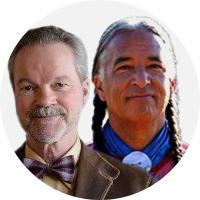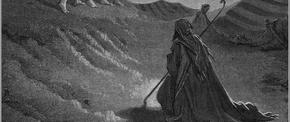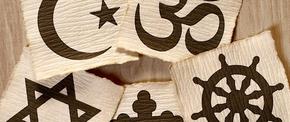The views expressed in our content reflect individual perspectives and do not represent the authoritative views of the Baha'i Faith.
In this installment of our continuing series on Indigenous messengers of God, we examine the life and teachings of Nanabush, the Anishinaabe (Ojibway) sacred teacher and trickster.
RELATED: Why We Need to Learn About Native American Prophets
Christopher Buck: Kevin, did you know that Henry Wadsworth Longfellow’s well-known 1855 poem, “The Song of Hiawatha,” was really about Nanabush?
Katy Young Evans, who wrote “The People’s Pageant: The Stage as Native Space in Anishinaabe Dramatic Interpretations of ‘Hiawatha,’” identified Nanabush as “the culture hero at the center of the oral traditions on which Longfellow’s poem is based.” Here’s her explanation about how that happened:
Nanabozho, the Anishinaabe culture hero and trickster, is variously named Manabozho, Menaboju, Weesakayjac, or Nanabush, among other iterations. See Theresa S. Smith, The Island of the Anishnaabeg: Thunderers and Water Monsters in the Traditional Ojibwe Life-World (1995), for discussion of how dialect differences resulted in these variations. Following Smith, I use Nanabush most frequently, as that is the name used by the Anishinaabeg in southern Ontario (Smith 171).
Longfellow condensed and rewrote parts of the Nanabush story cycle, which he had encountered in Henry Rowe Schoolcraft’s Algic Researches: Comprising Inquiries Respecting the Mental Characteristics of the North American Indians (1839), a collection of oral narratives shared by his Anishinaabe wife Jane Johnston Schoolcraft (Bamewawagezhikaquay) and her family and friends. Although some claim Longfellow’s publisher changed the name of the main character from Manabozho to Hiawatha, others, including Longfellow’s daughter Alice, claim the poet knowingly swapped it out, whether for acoustic effect or from his desire to elevate his main character from trickster to noble hero (Trachtenberg 81). Hiawatha, also called Hayowentha or Ayenwatha, was one of the founders of the Haudenosaunee Confederacy (Iroquois).
Interesting, isn’t it? Care to comment?
Kevin Locke: It’s wonderful that you bring out the differentiation between these two prominent characters: one a trickster/culture hero – Nanabush – and the other a staunch and valiant promulgator of the Peacemaker’s Great Law of Peace – Hiawatha. Longfellow took excessive poetic license, but he at least brought a misidentified proponent of one of the sacred covenants of this land into the general consciousness. This might be an accessible portal through which the general public can familiarize themselves with this great figure.
CB: In my own investigation, I have tried to learn something about Nanabush. Here’s what Henry Rowe Schoolcraft — based on the information provided by “his Anishinaabe wife, Jane Johnston Schoolcraft (Bamewawagezhikaquay) and her family and friends” — said in his book The Myth of Hiawatha, and Other Oral Legends, Mythologic and Allegoric, of the North American Indians:
The myth of the Indians of a remarkable personage, who is called Manabozho by the Algonquins, and Hiawatha by the Iroquois, who was the instructor of the tribes in arts and knowledge, was first related to me in 1822, by the Chippewas of Lake Superior. He is regarded as the messenger of the Great Spirit, sent down to them in the character of a wise man, and a prophet. But he comes clothed with all the attributes of humanity, as well as the power of performing miraculous deeds. He adapts himself perfectly to their manners, and customs, and ideas. He is brought up from a child among them. He is made to learn their mode of life. He takes a wife, builds a lodge, hunts and fishes like the rest of them, sings his war songs and medicine songs, goes to war, has his triumphs, has his friends and foes, suffers, wants, hungers, is in dread or joy—and, in fine, undergoes all the vicissitudes of his fellows. His miraculous gifts and powers are always adapted to his situation.
When he is swallowed by a great fish, with his canoe, he escapes by the exertion of these powers, but always, as much as possible, in accordance with Indian maxims and means. He is provided with a magic canoe, which goes where it is bid; yet, in his fight with the great wampum prince, he is counselled by a woodpecker to know where the vulnerable point of his antagonist lies. He rids the earth of monsters and giants, and clears away windfalls, and obstructions to the navigation of streams. But he does not do these feats by miracles; he employs strong men to help him. When he means to destroy the great serpents, he changes himself into an old tree, and stands on the beach till they come out of the water to bask in the sun. Whatever man could do, in strength or wisdom, he could do. But he never does things above the comprehension or belief of his people; and whatever else he is, he is always true to the character of an Indian.
This myth is one of the most general in the Indian country. It is the prime legend of their mythology. He is talked of in every winter lodge—for the winter season is the only time devoted to such narrations.
Kevin, your comments, please?
KL: It is very interesting that Longfellow swapped out these two figures. In a way it adds much confusion to an already mysterious topic – namely, how to view properly the station of Nanabush and other trickster/culture heroes. At least the name, Hiawatha, has been etched into a broader, non-Indigenous consciousness, albeit a false, now fossilized understanding.
The fact that Nanabush is regarded as having been sent by the Great Spirit and that so many diverse and wondrous qualities are attributed to him leads me to believe that his appearance and reality is from ancient times. It’s wonderful to imagine the inspiration, awe and wonder invoked across the continent around the warmth and glow of sacred fires as tales of these great heavenly beings are imparted down through the generations. The universal laws they brought, the great arts, crafts, medicines, foods and virtues they inspired, and the day of fulfillment they prophesied live on and can now be realized by a new generation.
RELATED: Standard-Bearers: The Spirituality of Native Americans
It’s also stunning how this description fits so congruently with the Baha’i understanding of the nature of a messenger of God, as expressed in the description Abdu’l-Baha gave in his writings about the coming of Baha’u’llah:
A trusted messenger hath arrived and hath, in the world of the spirit, delivered a message from God’s loved ones. This auspicious courier bringeth fragrances of great ardour and wafteth the life-giving breezes of the love of God. He maketh the heart to dance for joy and filleth up the soul with an ecstasy of love and rapture. So intensely hath the glory of Divine Unity penetrated souls and hearts that all are now bound one to another with heavenly ties, and all are even as a single heart, a single soul. Wherefore reflections of the spirit and impressions of the Divine are now mirrored clear and sharp in the deep heart’s core.
I beg of God to strengthen these spiritual bonds as day followeth day, and make this mystic oneness to shine ever more brightly … until universal fellowship, close and warm, and unalloyed love, and spiritual relationships, will connect all the hearts in the world. Then will all humankind, because of this fresh and dazzling bounty, be gathered in a single homeland. Then will conflict and dissension vanish from the face of the earth, then will mankind be cradled in love for the beauty of the All-Glorious. Discord will change to accord, dissension to unison. The roots of malevolence will be torn out, the basis of aggression destroyed. The bright rays of union will obliterate the darkness of limitations, and the splendours of heaven will make the human heart to be even as a mine veined richly with the love of God.
CB: Excellent! Now, Kevin, please watch the animated tale, “How the Buffalo Got His Hump,” in “Tales of the First People,” starting at 53:25 to 1:03:45. Your comments, please?
KL: Yes, this sounds like a great winter tale. I wonder what the source is? This is a great tale of a being who restores balance and exacts justice. Stories like this are terrific reminders of the consequence of improprieties such as tyranny, in that every time the individual is reminded of or sees a buffalo they can refer to the reason for the deformity. Such tales abound throughout the world. Nanabush is truly a universal figure.
CB: Amazon’s “Prime Video” description says: “From the creators of the award-winning “Raven Tales” comes “Tales of the First People.” Four stories spanning the beginning of our world to comedy to sacrifice and adventure. Each story inspired by First Nation folklore.”
Here we see a good example of the continuing emergence of Indigenous stories in popular culture. Some may object to the commercialization of such Indigenous cultural heritages, though. That is a separate discussion, involving debates about cultural appropriation. But there is something to be said about the universal, cross-cultural nature of these Indigenous traditions. From a Baha’i perspective, here is a public statement called “The Prosperity of Humankind” from the democratically-elected global leadership body of the world’s Baha’is, the Universal House of Justice:
The principle of collective trusteeship creates also the right of every person to expect that those cultural conditions essential to his or her identity enjoy the protection of national and international law. Much like the role played by the gene pool in the biological life of humankind and its environment, the immense wealth of cultural diversity achieved over thousands of years is vital to the social and economic development of a human race experiencing its collective coming-of-age.
It represents a heritage that must be permitted to bear its fruit in a global civilization. On the one hand, cultural expressions need to be protected from suffocation by the materialistic influences currently holding sway. On the other, cultures must be enabled to interact with one another in ever-changing patterns of civilization, free of manipulation for partisan political ends.
KL: Yes, that balance of protecting cultural expression and yet being open to cultural cross-pollination without exploitation describes the Baha’i approach beautifully.

















Comments
Sign in or create an account
Continue with Facebookor